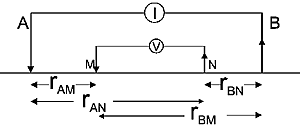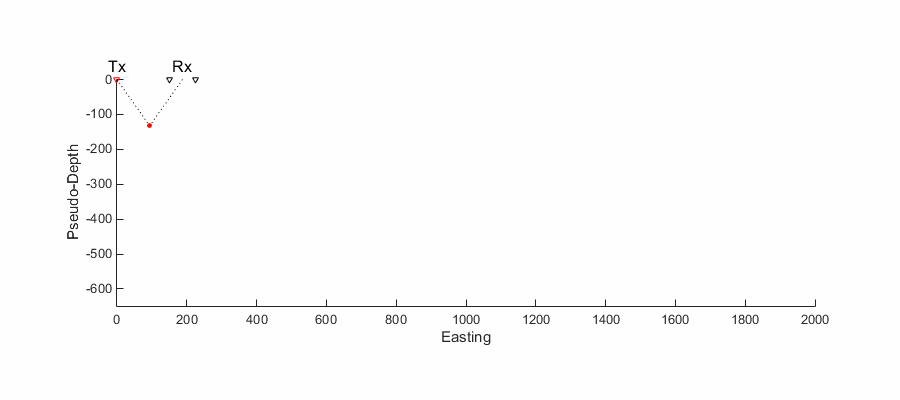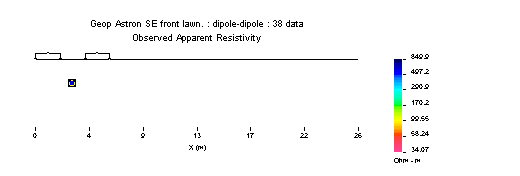Data
Introduction
For DC resistivity surveys, the energy source is a generator which injects a constant current into the ground using two electrodes. The “signals out” (data) are voltages measured at various places on the surface, along with strength of the known current source (in Amperes) and details about relative geometry of the four electrodes.
In order to create maps or graphs of raw data for quality assessment or for direct interpretations, measurements are converted into a form that is related to the relevant physical property. For each measurement, a 3D version of Ohm’s Law is used to generate a datum with units of resistivity (or conductivity). These transformed data are called apparent resistivities because they represent the earth’s true resistivity only if the ground is uniform. When subsurface resistivity varies, interpretation must be based upon the way in which apparent resistivity varies as a function of electrode geometry and position. The commonly used survey procedures are explained later on this page, after discussions about current flow, sources, measurements, and conversion to apparent resistivities.
Apparent resistivity
If there are two current (source) electrodes, the potential is the superposition of the effects from both. In a practical experiment (figure below), one electrode, \(A\), is the positive side of a current source, and the other electrode, \(B\), is the negative side. The current into each electrode is equal, but of opposite sign. For a practical survey, we need two electrodes to measure a potential difference. These are \(M\), the positive terminal of the voltmeter (the one closest to the \(A\) current electrode), and \(N\), the negative terminal of the voltmeter.

The measured voltage is a potential difference \((V_M - V_N)\) in which each potential is the superposition of the effects from both current sources:
In the final relation, \(G\) is a geometric factor which depends upon the geometry of all four electrodes. Finally, we can define apparent resistivity (discussed in the measurements section) by rearranging the last expression to give:
Similarly, the apparent conductivity is
We use the term apparent resistivity \(\rho_{a}\) because it is the true resistivity of materials only if the Earth is a uniform halfspace within range of the survey. Otherwise, this number represents some complicated averaging of the resistivities of all materials encountered by the current field.
For any survey we can compute the apparent resistivity if measured voltage, \(I\), and the geometric factor, \(G\) are known. Sometimes there is a simple expression for \(G\). For example, if electrodes are spaced equally by a distance \(a\), then:
\[G = \frac{ \frac{1}{a} - \frac{1}{2a} - \frac{1}{2a} + \frac{1}{a} }{2 \pi} = \frac{1}{2 \pi a}\]
This is the case for the “Wenner” array shown in Fig. 176, which summarizes the geometric factor for a variety of common electrode configurations. Note that in this figure, \(k=1/G\) . Usage of the various arrays is illustrated in the next section.

Fig. 176 Survey configurations for DC resistivity surveying.
Plotting raw data
How are apparent resistivities (calculated from measured potentials, currents and geometries) displayed for direct interpretation or for quality assessment? There is one conventional plotting scheme for soundings, while plotting of profiles depends upon the survey configuration.
Soundings
Soundings are used when the earth’s electrical structure needs to be interpreted in terms of layers under a single location at the surface. The electrode spacings are varied symmetrically about a central location.
|
Figure 8.
Therefore, data must be plotted as a function of electrode spacing rather than as a function of location. The resulting plot is called a sounding curve, and it arises as shown in this interactive figure (Figure 8). Only current electrodes are shown. Potentials would be measured inside current electrodes using either the Wenner or Schulmberger configurations.
|
||||||||||||
ProfilingSimple profiling involves moving a fixed array of four electrodes along a survey line. If there are no changes of spacing, then a simple graph of apparent resistivity versus line position would be adequate. A contour plot could be created if there is suitable coverage of the area. Pseudosections: When profiling, potentials are usually measured at several positions for every current source location. Results at wider separations between the potential pair and the transmitter pair provide some information about deeper structures. The conventional method of plotting such results is the pseudosection, so called because it is not a true geological cross- section. Values of apparent resistivity are plotted on the graph as shown in Figures 9 and 10. The vertical axis represents separation distance, NOT depth. When all values are plotted, the result is contoured. Interpretation is tricky and requires some experience.
In the animation in Figure 10, the process of gathering and plotting profiling data is illustrated. The survey illustrated involves a dipole-dipole array with \(a = 2\) meters, and \(n = 4\).
| ||||||||||||




